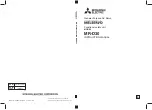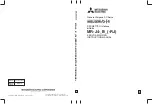
52
DMM Technology Corp.
DYN4 AC Servo Drive Instruction Manual
REV. ZM7-A10A
CT1
7.2 Packet Definition
Byte : consists of 8 bits, represented by b7b6b5b4b3b2b1b0 or b[7:0]. b7 is MSB and b0 is LSB, so called little
endian. Each packet consists of several bytes, expressed as:
Packet = Bn Bn-1 Bn-2 .... B1 B0
Packet length = n+1, Total n+1 bytes
Bn is start byte, B0 is end byte, similar to the byte structure, Bn is MSB and B0 is LSB as little endian rule.
The integer n varies as the variation of packet length. Functionally, a packet could be expressed as:
Packet = ID + packet functi data + checksum
Minimum packet length is 4 bytes, packet length 4 (n=3), 1 data byte.
Maximum packet length is 7 bytes, packet length 7 (n=6), 4 data byte.
Minimum packet length is 4. There is at least one data byte, for some function code that does not require data,
this data byte is meaningless, or called dummy byte which can be set to any value [0~127] and does not affect
the overall function of that packet.
ID
One byte (Start byte)
packet functioncode
One byte
data
One to four bytes
checksum
One byte
7.2.1 Structure
7.2.3 Start byte Bn
The MSB bit of start byte is always zero, the other seven bits are used for the Drive ID number which is set from
0 ~ 63. The ID number can also be assigned through the DMMDRV software.
ID number 127 is reserved for every drive for broadcasting purposes. In other words, 127 is general ID number.
ID numbers 64 ~ 126 are internally reserved.
The communicating servo drive must be set to the same ID number to accept and execute data. The drive ID
can only be set if the
RS485/232 Net
check box is not checked (in the DMMDRV software).
7.2.2 Features for the byte inside a packet
The start byte takes form of 0xxxxxxx, or MSB is 0, x for 0 or 1. Any other byte except the start byte takes the
form of 1xxxxxxx, where x could be 0 or 1. Most significant bit in a byte can be used for determining if it is a
packet’s start byte or not.
DYN232M
DYN232M
D Y N A C S E RV O S Y S T E M - R S 2 3 2 M O T I O N
TM
TM
DTPU
P O S I T I O N I N G
















































